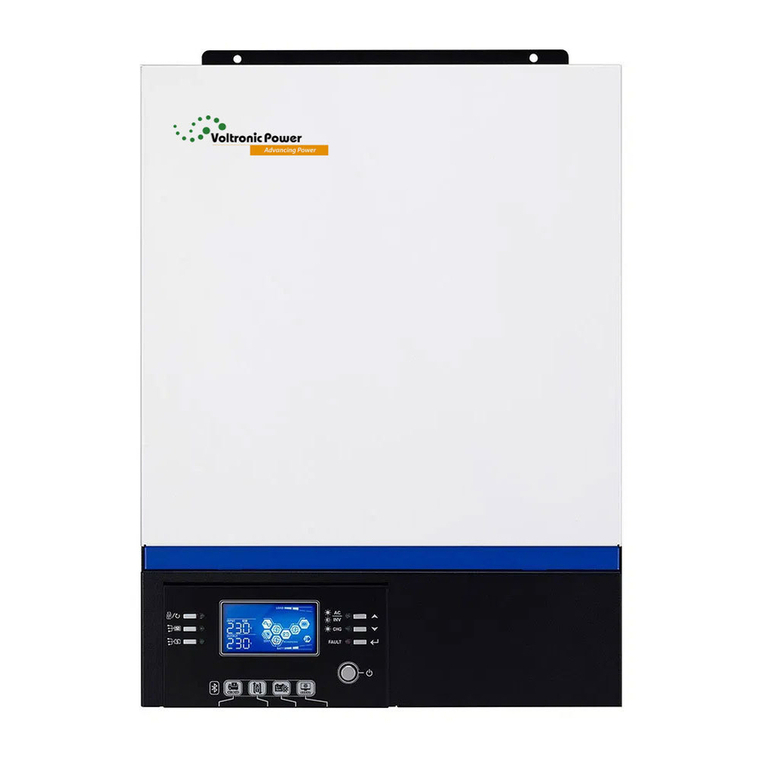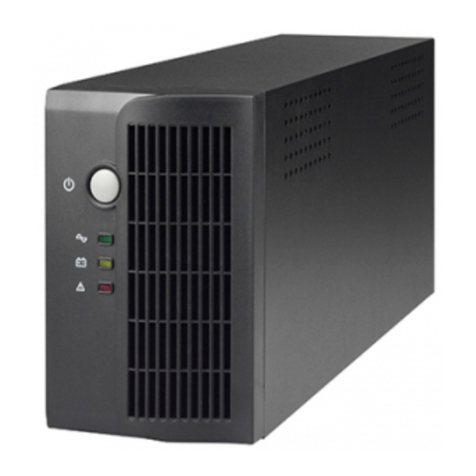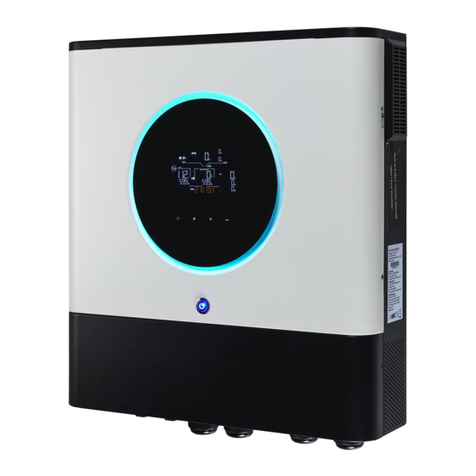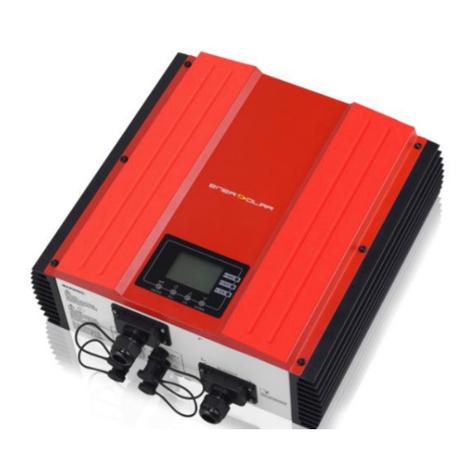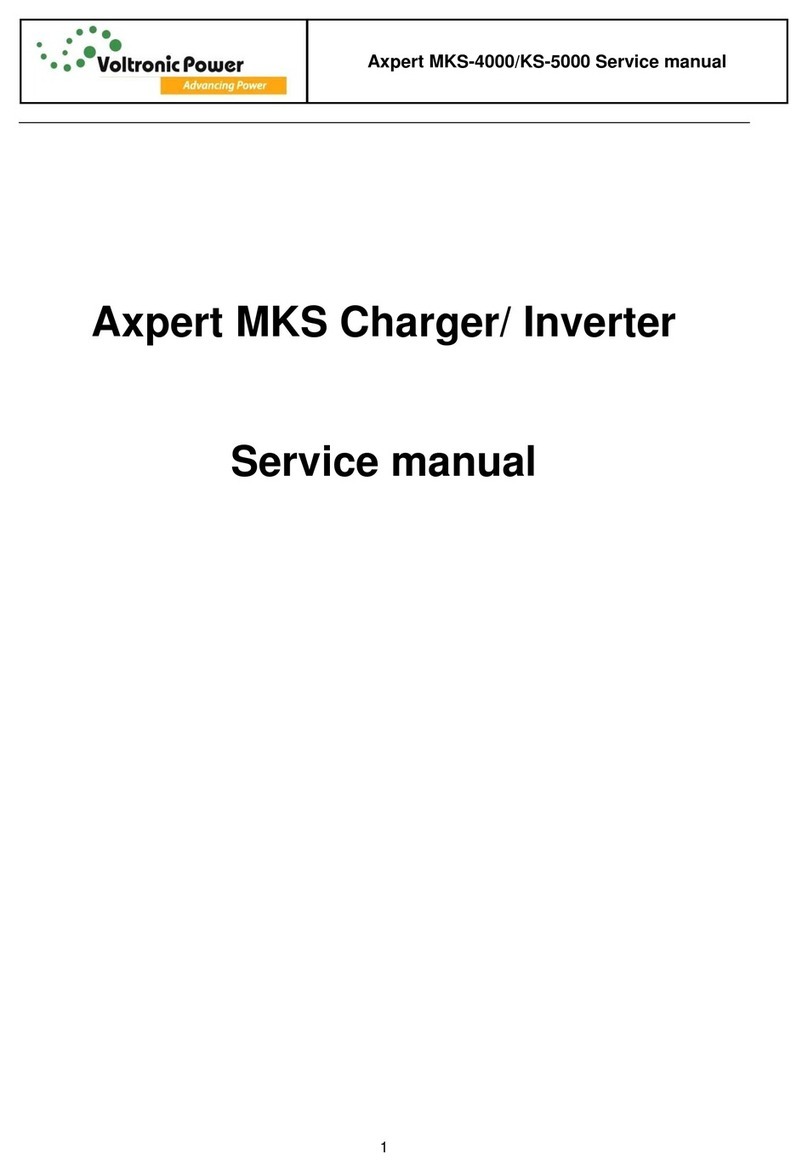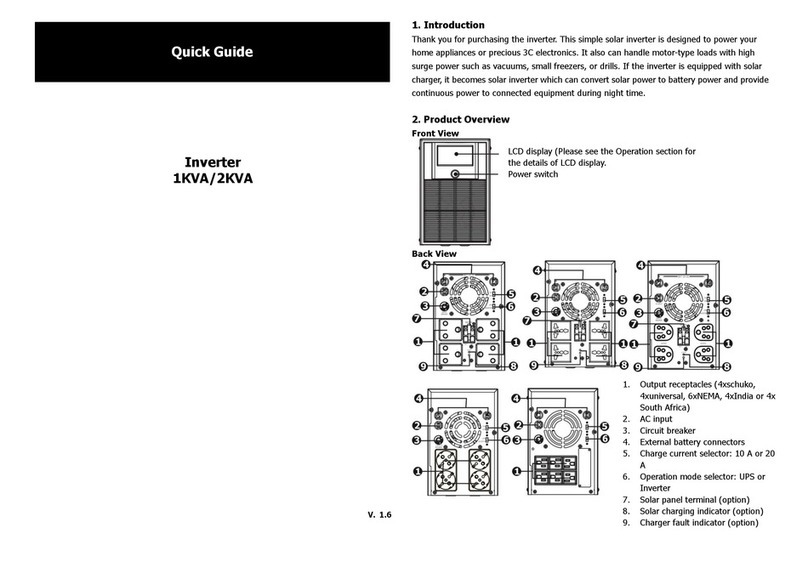5Installation
NOTE: Before installation, please inspect the unit. Be sure that
nothing inside the package is damaged.
IMPORTANT WARNINGS BEFORE MAKING BATTERY CONNECTION!!
CAUTION!! Remove personal metal items such as rings, bracelets, necklaces, and
watches when working with batteries.
CAUTION!! For the user operation safety, we strongly recommend that you should
use tapes to isolate the battery terminals before you start to operate the
unit. Please refer to below instruction for further information.
Step 1-Turn off the unit and unplug the unit to prevent electrical shock or sparks.
Step 2-Remove 4 screws located on the bottom of the unit to open the unit. To prevent
any shocks, please do NOT touch any inside components.
Step 3-Check if there is an internal battery inside. If yes, removing battery wires from
internal battery first.
NOTE: Do NOT make the battery short circuited, or it will cause the danger of
burning. To prevent any shocks, do NOT touch any inside components.
A. Replace Internal Battery
Step 1-Remove the old battery from the case.
Step 2-Make sure the new battery is the same type and nominal voltage to the old
battery.
Step 3-Connect the battery cables to the internal battery.
RED cable to the positive terminal (RED) of the battery;
BLACK cable to the negative terminal (BLACK) of the battery.
Step 4-Assemble the case with 4 screws.
Step 5-Power on the unit.
B. Modify Internal Battery Connection to External Battery Connection
Step 1-Remove the old battery from the case.
Step 2-Connect battery cable to external battery terminal on PCB.
RED cable to W7 : the positive terminal (RED+)(BAT+);
BLACK cable to W5: the negative terminal(BLK-)(BAT-)
Step 3-Assemble the case with 4 screws.
Step 4-Follow the procedures of External Battery Connection Section listed below.
Step 5-After completing external battery connection, power on the unit.
C. Modify External Battery Connection to Internal Battery Connection
Step 1-Before disassembling the unit, disconnect the external battery and external
battery cable first.
Step 2-Disassemble the unit.
Step 3-Disconnect the internal battery cable from the external battery terminal
(W5 and W7).
Step 4-Put internal battery into the case. Make sure the voltage of the new battery is
equal to the nominal battery DC voltage of the unit.
Internal Battery Section
Mounting the Unit
The unit can be mounted to a wall surface in two ways. Please follow below steps:
1. Turn off the unit before mounting.
2. Select an appropriate mounting location and mounting method.
Method 1:
Step 1: Use a horizontal line and the length of the line must be 120 mm and mark the
two ends on the wall. (see chart 1)
Step 2: Drill two marks by screws.
Step 3: Mount the unit by positioning the key-hole slots over the mounting screws.
(see chart 2)
Method 2:
Step 1: Use a vertical line and the length of the line must be 120 mm and mark the
two ends on the wall. (See chart 3)
Step 2: Drill two marks by screws.
Step 3: Mount the unit by positioning the key-hole slots over the mounting screws.
(see chart 4)
Operation
6
Power On/Off
Once the inverter has been properly installed, press the power switch to turn on the
unit. The unit will work automatically in line mode or inverter mode according to input
utility power's status. When press the power switch again, the unit will be turned off.
LED Indicators
There are three indicators (Green/Red/Yellow) in the front panel of the unit.
Status Indicato r
Full battery at Line mode.
Charging battery at Line
mode
Normal battery voltage at
Inverter mode.
Low battery at Inverter mode.
The output is short-circuited.
The unit is overload.
The unit is over charged.
Green LED lighting.
Green LED flashing every 3 seconds.
Yellow LED lighting.
Yellow LED flashing every 2 seconds.
Red LED lighting.
Red LED flashing for 0.5 second every second.
Red LED flashing every 5 seconds.
Trouble Shooting
7
Use the table below to solve minor problems.
Problem Probable Cause Solution
Utility power is
normal but the unit
is in inverter mode.
When power fails,
the backup time is
shorten.
No LED display on
the front panel when
the utility power is
normal.
AC input power cord is not
connected well.
Input fuse is blown.
The unit is overload.
Battery voltage is too low.
Battery capacity is not full
even after charge the unit
for at least 8 hours.
The unit is not turned on.
Battery is not connected
well.
Battery defect.
Battery voltage is too low.
Check AC input power
connection.
Replace the input fuse.
Remove some non-critical
loads.
Charge the unit at least
8 hours.
Check the date code of the
battery. If the batteries
are too old, replace the
batteries.
Press power switch to turn
on the unit.
Check the external battery
cable and terminal. Make
sure all the battery
connections to the unit are
all correct.
Replace the batteries.
Charge the unit at least
8 hours.
If there is any abnormal situations occur, which doesn't list above, please call the
service people immediately for professional examine.
Step 5-Connect the battery cable to the internal battery.
RED cable to the positive terminal (RED) of internal battery;
BLACK cable to the negative terminal (BLACK) of internal battery.
Step 6-Assemble the unit with 4 screws.
Step 7-Power on the unit.
Step 1- Following battery polarity guide printed near the battery terminal!
Place the external battery cable ring terminal over the battery terminal.
RED cable to the positive terminal (+);
BLACK cable to the negative terminal (-).
Step 2- Tight the screws. Do NOT place anything between the flat part of battery
terminal and the battery cable ring terminal, or overheating may occur.
Step 3- Connect battery cables to the external batteries.
Note: For the user operation safety, we strongly recommend that you should use tapes
to isolate the battery terminals before you start to operate the unit.
1)Single battery connection(Refer to Fig. 1):
When using a single battery, its voltage must be equal to the Nominal DC Voltage
of the unit (see below Table 1).
RED cable to the positive terminal (+) of external batteries;
BLACK cable to the negative terminal (-) of negative batteries.
External Battery Connection
WARNING! Please use the appropriate battery cable. Please refers to Important
Safety Warnings Section for the details.
Model Nominal Battery DC Voltage
VIVA 30 12 VDC
Table 1
Fig. 1
2)Multiple batteries in series connection(Refer to Fig. 2):
All batteries must be equal in voltage and amp hour capacity. The sum of their
voltages must be equal to the nominal DC Voltage of the unit.
+
-
+
-
Fig. 2
-
+
+
-
+
-
+
-
Fig. 3
-
+
Model Nominal Battery DC Voltage
VIVA30 12 VDC
3)Multiple batteries in parallel connection (Refer to Fig. 3):
Each battery voltage must be equal to the Nominal DC Voltage of the unit.
Chart 3 Chart 4
Chart 1 Chart 2
Method 1: Method 2:
+-+
-
